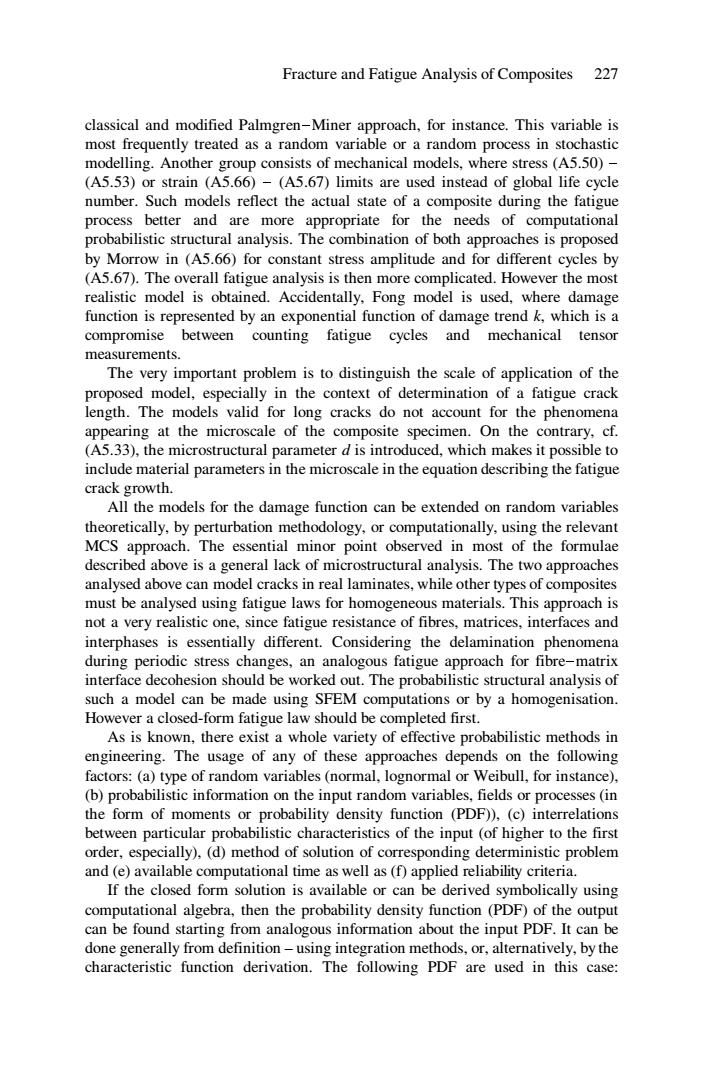正在加载图片...

Fracture and Fatigue Analysis of Composites 227 classical and modified Palmgren-Miner approach,for instance.This variable is most frequently treated as a random variable or a random process in stochastic modelling.Another group consists of mechanical models,where stress (A5.50)- (A5.53)or strain (A5.66)-(A5.67)limits are used instead of global life cycle number.Such models reflect the actual state of a composite during the fatigue process better and are more appropriate for the needs of computational probabilistic structural analysis.The combination of both approaches is proposed by Morrow in (A5.66)for constant stress amplitude and for different cycles by (A5.67).The overall fatigue analysis is then more complicated.However the most realistic model is obtained.Accidentally,Fong model is used,where damage function is represented by an exponential function of damage trend k,which is a compromise between counting fatigue cycles and mechanical tensor measurements. The very important problem is to distinguish the scale of application of the proposed model,especially in the context of determination of a fatigue crack length.The models valid for long cracks do not account for the phenomena appearing at the microscale of the composite specimen.On the contrary,cf. (A5.33),the microstructural parameter d is introduced,which makes it possible to include material parameters in the microscale in the equation describing the fatigue crack growth. All the models for the damage function can be extended on random variables theoretically,by perturbation methodology,or computationally,using the relevant MCS approach.The essential minor point observed in most of the formulae described above is a general lack of microstructural analysis.The two approaches analysed above can model cracks in real laminates,while other types of composites must be analysed using fatigue laws for homogeneous materials.This approach is not a very realistic one,since fatigue resistance of fibres,matrices,interfaces and interphases is essentially different.Considering the delamination phenomena during periodic stress changes,an analogous fatigue approach for fibre-matrix interface decohesion should be worked out.The probabilistic structural analysis of such a model can be made using SFEM computations or by a homogenisation. However a closed-form fatigue law should be completed first. As is known,there exist a whole variety of effective probabilistic methods in engineering.The usage of any of these approaches depends on the following factors:(a)type of random variables(normal,lognormal or Weibull,for instance), (b)probabilistic information on the input random variables,fields or processes(in the form of moments or probability density function (PDF)),(c)interrelations between particular probabilistic characteristics of the input (of higher to the first order,especially),(d)method of solution of corresponding deterministic problem and (e)available computational time as well as(f)applied reliability criteria. If the closed form solution is available or can be derived symbolically using computational algebra,then the probability density function(PDF)of the output can be found starting from analogous information about the input PDF.It can be done generally from definition-using integration methods,or,alternatively,by the characteristic function derivation.The following PDF are used in this case:Fracture and Fatigue Analysis of Composites 227 classical and modified Palmgren-Miner approach, for instance. This variable is most frequently treated as a random variable or a random process in stochastic modelling. Another group consists of mechanical models, where stress (A5.50) - (A5.53) or strain (A5.66) - (A5.67) limits are used instead of global life cycle number. Such models reflect the actual state of a composite during the fatigue process better and are more appropriate for the needs of computational probabilistic structural analysis. The combination of both approaches is proposed by Morrow in (A5.66) for constant stress amplitude and for different cycles by (A5.67). The overall fatigue analysis is then more complicated. However the most realistic model is obtained. Accidentally, Fong model is used, where damage function is represented by an exponential function of damage trend k, which is a compromise between counting fatigue cycles and mechanical tensor measurements. The very important problem is to distinguish the scale of application of the proposed model, especially in the context of determination of a fatigue crack length. The models valid for long cracks do not account for the phenomena appearing at the microscale of the composite specimen. On the contrary, cf. (A5.33), the microstructural parameter d is introduced, which makes it possible to include material parameters in the microscale in the equation describing the fatigue crack growth. All the models for the damage function can be extended on random variables theoretically, by perturbation methodology, or computationally, using the relevant MCS approach. The essential minor point observed in most of the formulae described above is a general lack of microstructural analysis. The two approaches analysed above can model cracks in real laminates, while other types of composites must be analysed using fatigue laws for homogeneous materials. This approach is not a very realistic one, since fatigue resistance of fibres, matrices, interfaces and interphases is essentially different. Considering the delamination phenomena during periodic stress changes, an analogous fatigue approach for fibre-matrix interface decohesion should be worked out. The probabilistic structural analysis of such a model can be made using SFEM computations or by a homogenisation. However a closed-form fatigue law should be completed first. As is known, there exist a whole variety of effective probabilistic methods in engineering. The usage of any of these approaches depends on the following factors: (a) type of random variables (normal, lognormal or Weibull, for instance), (b) probabilistic information on the input random variables, fields or processes (in the form of moments or probability density function (PDF)), (c) interrelations between particular probabilistic characteristics of the input (of higher to the first order, especially), (d) method of solution of corresponding deterministic problem and (e) available computational time as well as (f) applied reliability criteria. If the closed form solution is available or can be derived symbolically using computational algebra, then the probability density function (PDF) of the output can be found starting from analogous information about the input PDF. It can be done generally from definition – using integration methods, or, alternatively, by the characteristic function derivation. The following PDF are used in this case: